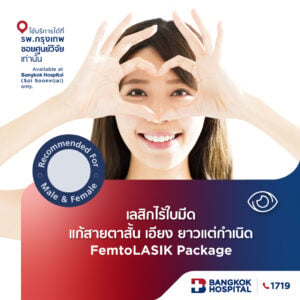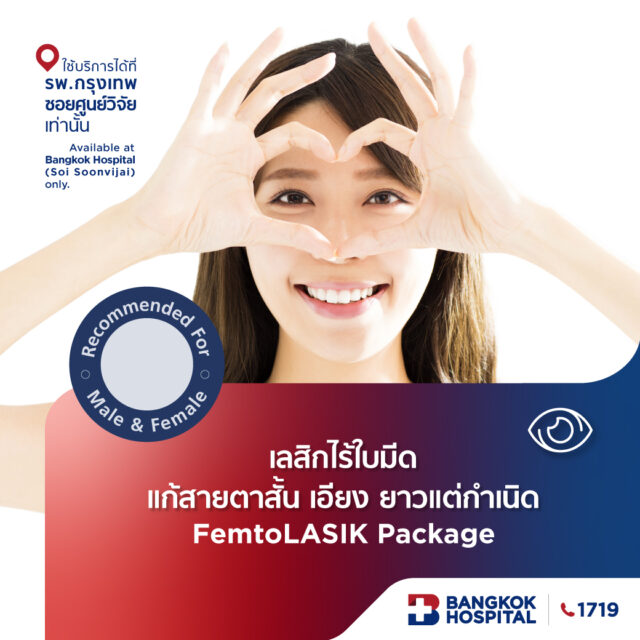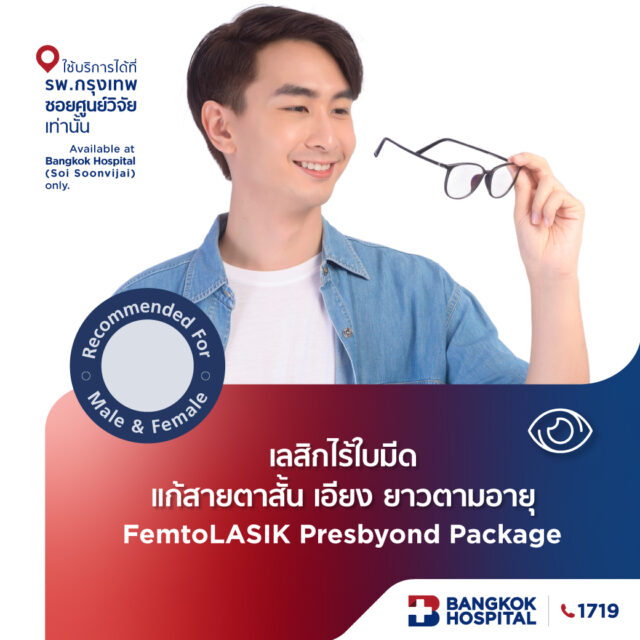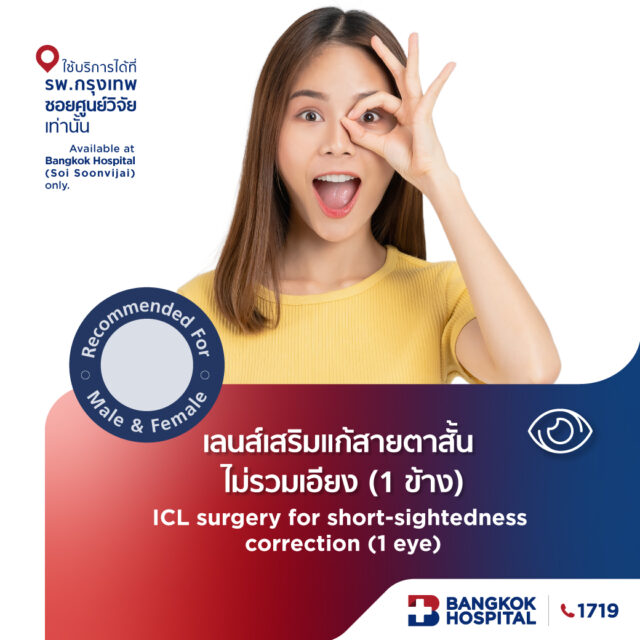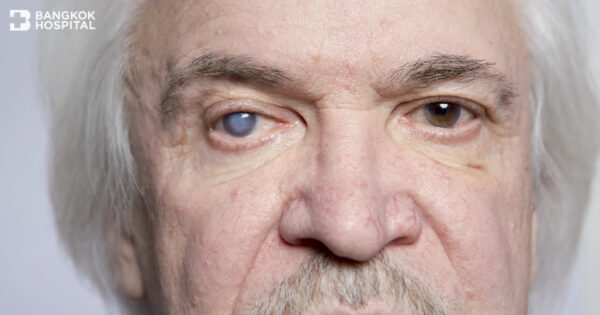During exposing to the sun, we often protect our skin by applying sunblock, but we might forget that the eyes need sun protection as well. Despite the fact that eyes only account for 2% of total body surface area, UV radiation from natural sunlight can drastically damage the eye’s surface tissues as well as main components e.g. the cornea and lens. The structures and functions of the eyes are complex. The eyes are naturally protected by the orbit –the bony cavity that contains the eyeball, muscles, nerves and blood vessels. Eyelids, eyebrows and eye lashes also act as eye protective layers. In addition, constriction response or the narrowing of the pupil, eye closure and eye squinting are naturally protective mechanisms when the eyes are irritated by visible light. Nonetheless, these mechanisms are not activated by invisible UV radiation. On a day without bright sunlight, the body is still exposed to a large amount of UV radiation, therefore UV radiation does not stimulate the natural defenses of the eyes.
Types of UV radiation
The sun emits ultraviolet rays, shortly called UV rays.
UV rays are invisible light waves that have shorter wavelengths than the visible light. Visible wavelengths cover a range from approximately 400 to 700 nm. while invisible wavelengths with stronger penetrating power are shorter than 400 nm. Based on the measurement of their wavelengths, UV radiation is classified into three primary types: ultraviolet C (UVC), ultraviolet B (UVB) and ultraviolet A (UVA). All types of UV radiation have the potential to damage eyes and skin. However each type affects eye and skin differently.
- Ultraviolet C or UVC (wavelengths: 100–280 nm.)
UVC is the most powerful ray. It is the most damaging to the skin and eyes. Normally, the majority of UVC is absorbed by the ozone layer in the atmosphere. However, the recent ozone depletion in the atmosphere allows more harmful UVC penetration into the earth, causing health–related conditions.
- Ultraviolet B or UVB (wavelengths: 280 – 320 nm.)
Compared to UVC, UVB has a lower energy. It is mostly absorbed by the ozone layer, but some does reach the earth’s surface. UVB affects the epidermis (outer layer of the skin) and increases the melanin production. This results in skin damages e.g. sunburn, blistering, dark spots and wrinkles as well as an increased risk of skin cancer. In relation to the eyes, UVB affects the corneas, causing eye problems, such as severe irritation and light sensitivity.
- Ultraviolet A or UVA (wavelengths: 320 – 400 nm.)
Although UVA with longer wavelengths is less powerful than UVC and UVB, UVA is the one that largely penetrates the eyes through the lens and retina. Excessive exposure to UVA has been associated with the developing of cataract. There is clinical evidence revealing that UVA is one of the potential risk factors that contribute to macular degeneration described as a blurred or no vision in the center of the visual field.
Eye damage from the sun
Long–term exposure to the sun causes damages to the eyes. Damages caused by UV radiation can affect different parts, including:
- Eyelid: Excess UV radiation causes altered skin color of the eyelid, presenting with dark spots, loose skin and wrinkles. Moreover, clinical studies indicate that certain types of skin cancer presenting in the eyelid e.g. basal cell carcinoma and squamous cell carcinoma are related to long–term sunlight exposure.
- Conjunctiva: Conjunctiva is the gelatinous layer that covers the white of the eye just outside of the colored part. Eye irritation induced by wind, dust and UV radiation from sunlight can potentially cause pinguecula which is a non–cancerous growth that forms on the conjunctiva, or white tissue near the cornea. Pinguecula presents as a white or yellow raised area or bump within the conjunctiva. With continued sun exposure, pinguecula can grow from the white part of the eye onto the cornea, which is the clear front part of the eye, known as pterygium. Since pterygium is a white, wedge or wing–shaped growth over clear tissue, patients often present with cosmetic concern. If this continues growing, it may lead to corneal inflammation, scarring of the cornea and eye pain, leading to permanent vision loss or distortion.
- Cornea: Ultraviolet exposure can often induce acute cornea inflammation or keratitis. Common symptoms of keratitis are sudden eye pain, tearing and blurred vision. Without wearing proper eye protective equipment, these symptoms might occur 2-3 hours and last for 2-3 days after excessive exposure to the sources of UV radiation e.g. the reflection of snow from snow-covered surfaces and welding that emits intense ultraviolet radiation
- Lens: Cataract is clouding of the lens of the eye which prevents clear vision. Though it is thought that people can develop cataract over time as we age, there is evidence that those who have constant exposure to the sun are at greater risk to develop cataract more rapidly. According to the WHO assessment, cataract has caused blindness in approximately 16 million people worldwide. Statistical data derived from WHO also indicate that an overexposure to UV radiation which is considered avoidable factor contributes to 20% of cataract cases.
- Lens: Cataract is clouding of the lens of the eye which prevents clear vision. Though it is thought that people can develop cataract over time as we age, there is evidence that those who have constant exposure to the sun are at greater risk to develop cataract more rapidly. According to the WHO assessment, cataract has caused blindness in approximately 16 million people worldwide. Statistical data derived from WHO also indicate that an overexposure to UV radiation which is considered avoidable factor contributes to 20% of cataract cases.
Blue light and the eyes
Blue light is a range of the high–energy visible light spectrum, defined as having a wavelength between 381−500 nm. which is close to the UV light. Owning to blue light has considerably short wavelengths, it produces a higher amount of energy. Blue light penetrates deeply to cells and causes permanent cell damages. Prolonged exposure to blue light may cause retinal damage and contribute to age-related macular degeneration, which can lead to central loss of vision. Clinical studies strongly indicate that too much exposure to blue light can profoundly damage light–sensitive cells in the retina, eventually leading to permanent central vision loss.
According to an European study published in the October 2008 issue of Archives of Ophthalmology, people who have low blood plasma levels of vitamin C and other antioxidant substances have a greater risk to develop macular degeneration due to accumulative effects of exposure to blue light.
Blue light is everywhere. Manmade sources of blue light include the display screens of computers, flat–screen televisions, fluorescent and LED lighting, smartphones and other digital devices as well as laser and certain medical devices. While the cornea and lens of the eye are effective at blocking UV rays from reaching retina, almost all visible blue light passes through these natural barriers. It could reach and damage the delicate retina. The blue light blocking lenses are usually a pale orange or yellow tint. These lenses acting as blue blockers have filters in their lenses that block or absorb blue light from getting through. Since blue light has wavelengths close to UV radiation, blue light blocking lenses can help filtering UV light as well.

Choosing proper eye protective glasses
Excess exposure to UV light raises risks of eye diseases. It is important to start wearing proper eye protection at an early age to shield the eyes from years of ultraviolet exposure.
- To protect the eyes, selected sunglasses should be able to block both UVA and UVB 99–100% with clearly specified labels. The effectiveness of UV protection does not depend on the color or the intensity of the lenses.
- Size of the lenses should be large and wide enough to fully cover the entire eyes for better protection against UV rays reaching the eyes from all angles.
- Sunglasses, in addition to protecting against UV rays, they should have other attributes, including:
- The blue light blocking lenses: Blue light blocking lenses ease the visualization of distant objects, especially in snow or cloudy weather. These lenses that completely block all blue light are in amber shade. However, it is advisable to use gray lenses for driving in order to correctly see the color of the traffic light.
- Polarized Lenses: The surface of polarized lenses block the glare by filtering out the horizontal light waves that do not fit through the chemical laminate pattern. When the glare is eliminated, the image details are easier to see, especially in the reflective surfaces e.g. water and snow.
- Photochromic lenses: Photochromic lenses are able to automatically adjust the light intensity. Lenses are clear (or nearly clear) indoors and darken when exposed to sunlight.
- Polycarbonate lenses: Polycarbonate or impact–resistant lenses are shatter–proof lenses aiming to protect physical impacts to the eyes.
- Mirror – coated lenses: Mirror –coated lenses have reflective coating to help redirecting sunlight from the surface of lenses.
- Gradient lenses: Gradient lenses feature a gradual shift in tint from top–down, so that the top of the lens is darkest whereas the bottom is lightest. These lenses help to reduce diffused light, allowing clearer vision which are suitable for driving. Double–gradient lenses refer to gradient lenses where the top and bottom portions of the lenses are dark and the middle of the lens has a lighter tint. These lenses are useful for water or winter sports.


